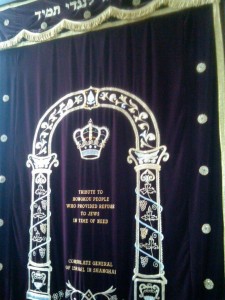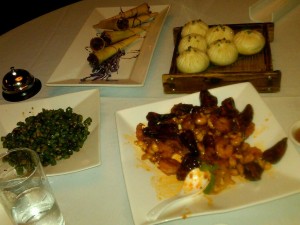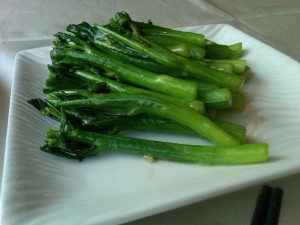Arrived last night in Shanghai for one of my three or so annual visits to my MIT dual-degree program‘s sister program here, China Leaders for Global Operations. It is an MBA plus Engineering Master’s program, as at MIT, with curriculum provided by MIT and courses taught in English. The MIT LGO program helped get it started five years ago when our partner companies said they needed to develop a source of Chinese leadership for their manufacturing and operations here.
Apart from meetings and getting to know the new class of CLGO students, who just arrived this week and had a bit of a trial by fire just now as they asked our MIT director questions in English, I got to escape today to visit the Shanghai Jewish Refugees Museum, proud owner of a pretty awesome domain name, “shanghaijews.org.cn”. Many people know that 30,000 or so Jews from Europe managed to escape the Holocaust by going to Shanghai, thanks in part to brave Chinese ambassadors. The museum is set up in the former Ohel Moshe synagogue where the refugees worshiped. What I didn’t know is that there was a tiny but prosperous Sephardic community in Shanghai, including the Sassoon family, from the 1800s onward, and that tens of thousands of Russian Jews also came through Shanghai in the early 1900s. My tour guide, a young Chinese woman, explained that the Nazis sent an emissary to Japanese-occupied Shanghai to attempt to persuade the Japanese to kill the Jewish refugees. But, she said, “the Japanese Nazis only put the Jews in a ghetto, but didn’t kill them.”

A work of art depicting Jewish life in Shanghai, which soulfully demonstrates the undying power of Jewish kitsch
The Chinese certainly know from tsuris, Japanese Nazi- or Chinese Communist-induced, and the exhibits at the museum all spoke movingly about the absence of anti-semitism felt by the refugees. I felt a strong sense of connection to the little synagogue I was part of in Lisbon, also founded by early 20th century Jews on their way out of Europe, and now a community of Portuguese people reclaiming their long-obscured Jewish ancestry. Finally, I cannot let this post pass without noting the strange and wonderful phenomenon of Chinese-born scholars of Judaica and Jewish history in China.
Now, having said a little brucha as it were, on to the food. I was delighted to have the chance to come to Shanghai, in no small part because I hoped to have a truly epiphanal experience of soup dumplings, popularized in New York by Joe’s Shanghai restaurant. In
the words of globe-trotting food critic Bono, I still haven’t found what I’m looking for, but not for lack of trying. Last night my Shanghai-born MIT colleague and I went for dinner and did OK. The highlight for me was probably the Kung Pao shrimp, which my legion of friends who hate Wu’s Garden Restaurant in Vienna, Virginia will recognize as a totemic recipe that I have to try wherever I go. The braised green beans were also pretty good. But Jeff explained that the dumplings had clearly been prepared hours before, since the filling was pretty tasty but the wrappers had gone soggy on the inside.
Today’s lunch was a simple noodle dish and a plate of braised Kai Lan (Chinese broccoli) with ginger. The Kai Lan were nice and crisp, and other long-suffering parents will no doubt share my pleasure in imagining cartoon Kai Lan saying, “Ouch! Oh, I mean, ni hao, but I wish you wouldn’t eat my leg! Oh golly, that sure smarts! Ni hao!” Tonight we went to a trés fancy place called Villa du Lac in the Xintiandi district that is both posh foreigner central AND the birthplace of the Communist Party of China! There was a surprise return visit of Kai Lan (“OK, ni hao but this time leave me alone!”) but highlights were probably the solo breaded crab claws (pictured), mini lettuce wraps with duck and pine nuts (much better than the duck and pine nuts in a pastry cone we had last night), and sirloin in XO sauce.
The service and timing were exquisite, right down to some guy from a private dining room holding off on rushing past us to boot violently in the bathroom until right after we finished eating. Onward and upward tomorrow, hopefully with dinner at Taiwanese dumpling joint Din Tai Fung.





Why did I read this at 10:30 am Cambridge time? Sounds delicious. “Only” an hour and a half till lunch.
For a Jew, being in China must be like Christmas every day! 😉 Looks delish. And love the blog.
My parents, being young adults in Taiwan in the 1960s loved Din Tai Fung. A namesake restaurant in the Toronto area is Julie’s favorite (although for “mini-dumplings”, not soup). Have a great meal tomorrow!